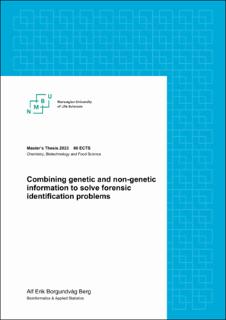| dc.contributor.advisor | Thore Egeland | |
| dc.contributor.author | Berg, Alf Erik Borgundvåg | |
| dc.date.accessioned | 2023-08-30T16:27:09Z | |
| dc.date.available | 2023-08-30T16:27:09Z | |
| dc.date.issued | 2023 | |
| dc.identifier | no.nmbu:wiseflow:6872796:55209851 | |
| dc.identifier.uri | https://hdl.handle.net/11250/3086459 | |
| dc.description.abstract | Forensic identification is the process of identifying for judicial purposes using scientific methods. Such techniques may be applied to humans, animals or objects. In this thesis the focus is on identifying humans. Forensic identification problems involving humans range from standard paternity cases to complex identification problems involving a large number of victims. In a murder case there may be trace evidence at the crime scene which helps identify the perpetrator. In a paternity case DNA analysis can determine whether or not a man fathered a child.
In identification cases investigators will make multiple hypotheses in the form of pedigrees. Out of these at most one can be true. The most likely hypothesis may be found through statistical analysis. Several forensic methods exist and may be applied for identification. When multiple data sources are available, it would be favourable for researchers to be able to combine the results based on all available data. The goal of this thesis is to provide a framework for solving identification problems using multiple forms of data for the same hypothesis tests. Specifically, DNA data will be paired with other non-genetic data in the data analysis.
Combining DNA with other data from the forensic case is desired because it allows researchers more material to draw conclusions from. This is particularly useful in cases where no conclusion may be drawn from DNA analysis alone. One such case involves two full siblings of the same sex who have gone missing, where neither sibling has descendants. If DNA is found from one of them, it is impossible to determine which of the siblings it belongs to even if DNA data from their family is accessible. Another way other data may assist in a forensic case is that information like age may be used to limit the hypotheses space, thus simplifying the forensic case. This emphasizes why multiple types of forensic data should be used in forensic analysis. The concept of combining different kinds of information for identification is the core of this thesis. | |
| dc.description.abstract | | |
| dc.language | eng | |
| dc.publisher | Norwegian University of Life Sciences | |
| dc.title | Combining genetic and non-genetic information to solve forensic identification problems | |
| dc.type | Master thesis | |
